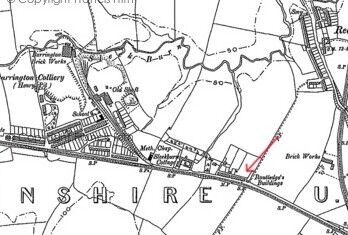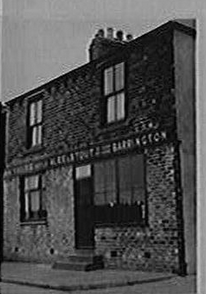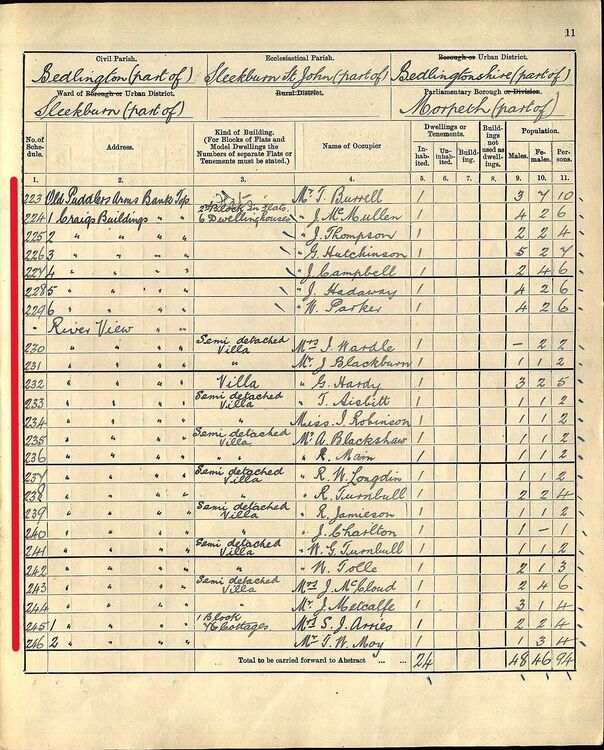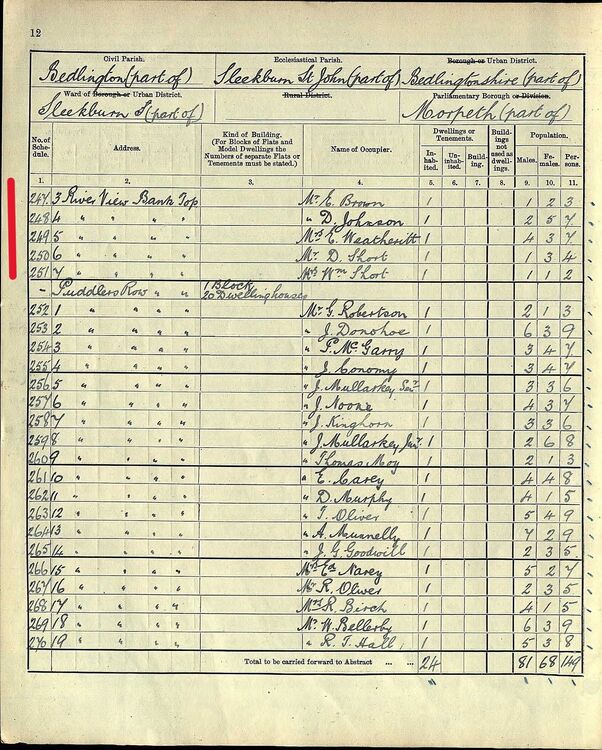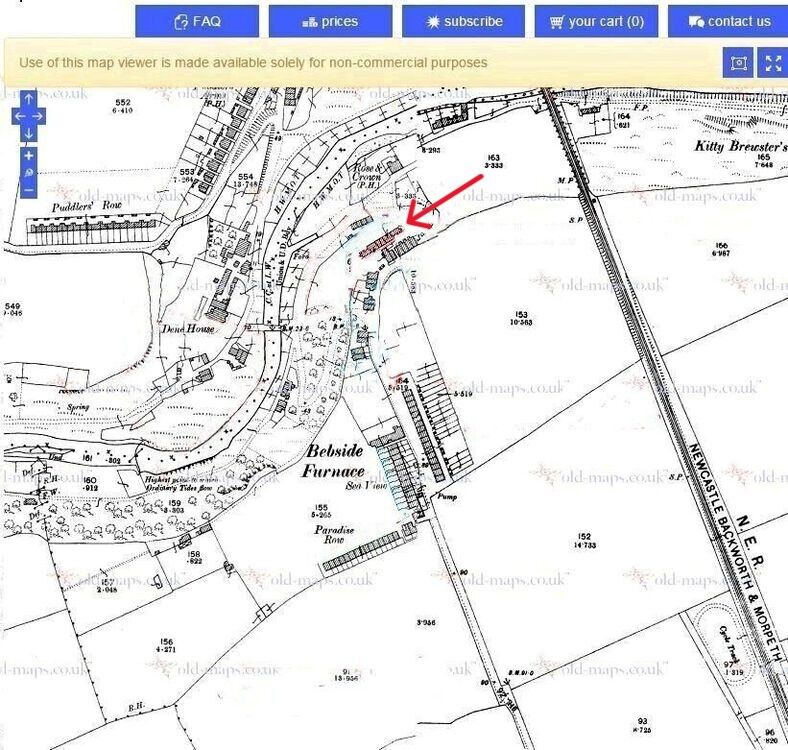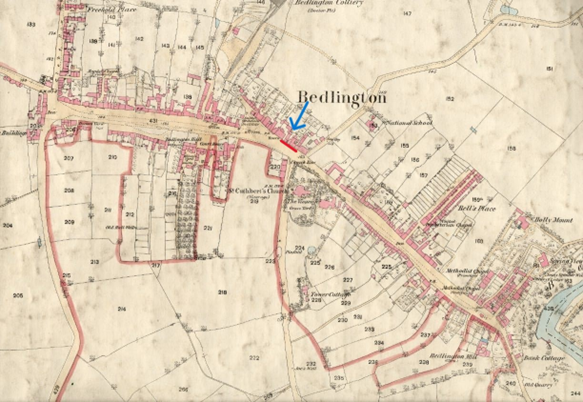.jpg.cdd7f8371d17e2f2f2e2a0e21e02f727.jpg)
Canny lass
Supporting Members-
Posts
3,596 -
Joined
-
Last visited
-
Days Won
407
Content Type
Forums
Gallery
Events
Shop
News
Audio Archive
Timeline
Everything posted by Canny lass
-
It's confirmed on NCC's website. Well done Malcolm! https://beta.northumberland.gov.uk/elections/2025-county-council-election-results-summary
-
I know very little about the content of the photo I posted above. I inherited it, and a lot of other material, many years ago from a former colleague and fellow researcher. Today I did a quick bit of research on Routledge’s Buildings. They may well have been several buildings – if the number of families living in them is anything to go by. In 1881 there were 25 families living in Routledge’s Buildings, Barrington. Nothing is known of the size of the individual family’s accommodation. One resident is Jane Routledge, a 62 year old widow, living with her two daughters of 20 and 15 years and her two sons, Robert 23 years and John 18 years, all with their roots in Cowpen and Bebside. In 1891 there are 31 families living in Routledge’s Buildings. Most accommodation seems to be of 2 rooms per family though the occasional 3 or 4 room dwelling does appear. John Routledge is still in the same house. In 1901 there are 27 families in Routledge’s Buildings. John Routledge is still there. The number of rooms per family varies from 2 to 5, though mostly 2. All in all, there are 74 rooms accounted for in the census returns for the address. Clearly, that is many more than would possible in the building on the photo. Next step – look at the building on maps! On the following map, dated 1896, I can clearly see that Routledge’s Buildings is infinitely bigger than in the photo. Furthermore, it appears to be built in two blocks. I’d suggest therefore that the photo is only part of Routledge’s buildings.
-
@7RIrF This is the only picture I have of Routledge Buildings. As you see it's not a row or terrace. It's just a 'building'. In my experience most of the addresses including the word "buildings" were exactly that - a building. It's a bit misleading that it's usually in the plural form 'buildings'. As for the name they usually, but not always, take their name from the surname of the owner. If you can yell me just which census you found Routledge Buildings in I can probably help you a bit more. What exactly do you mean by "(Blank) Buildings"?
-
Well! That was a nice little wander around a place I love, and looking so much better than it's ever done before. Thank you Malcolm for all your hard work.
-
@loopylou I can certainly agree that Clarkes Cottages and the Craigs Bldgs adjoining the Puddler's Arms are one and the same thing. My only reservation is that the 4 dwellings of Craigs Bldgs have become 9 dwellings in Clarkes Cottages - but it is possible. However, I'd be hesitant to say that Millfield Cottages are the same thing as the flats in Craigs Bldgs. It seems like an odd thing to call a flat a cottage. It needs some more work. If we get a bit of rainy weather this week I'll have another look at the area. Have you read any of the posts in the topic "Puddlers Raa (Row)"? There's some interesting info from people with first-hand knowledge of the area. You'll need to get your wellies on to read it as you'll have to 'wade' through a lot of info which isn't directly related to Puddler's Row. We do tend to digress a bit on this forum! One of the things you'll find in the topic is this photo of Liddle's buildings from 1910. The angle on the corner suggests to me that it may be the building marked in orange here. It's definitely on a corner!
-
-
Make a cup of tea, there's no way of explaining this quickly! This may throw a little light on the mystery! The enumerator for Bedlington, District 9 in the 1911 census, was one J W Gaskin. He appears to have been a man who took his work very seriously. Going above and beyond the call of duty in meticulously recording the statutory requirements: name, age, birthplace etc. of each person he recorded even a brief description of the building in which the residents lived. From these descriptions I think its now possible to identify the buildings at Bank Top – at least in 1911. @loopylou Yesterday you described the census for 1911 in the following manner. (I’ve taken the liberty of colour coding your text so that I can compare them to census records, photos and maps. Unfortunately I can't use coloured text here). You said: “No. 1 Craggs (missing, a shop? Uninhabited?) BLUE No. 2 Craggs Buildings (Weightman) BLUE No. 3 Craggs Buildings (Elliott) BLUE No. 4 Craggs Buildings (Kinghorn) BLUE following these are Old Puddlers Arms (Mawson) GREEN Old Puddlers Arms (Thain) GREEN Old Puddlers Arms (Cole) GREEN Old Puddlers Arms (Burrell) GREEN All of these addresses ”Old Puddlers Arms” have two rooms each, which equates with the eight rooms described in the auction. then confusingly Craggs Buildings (no number) (McMullen) RED No. 2 Craggs Buildings (Thompson) RED No. 3 Craggs Buildings (Hutchinson) RED No. 4 Craggs Buildings (Campbell) RED No. 5 Craggs Buildings (Hadaway) RED Craggs Buildings (no number) (Parker) RED These also had two rooms each. Then after follows River View. It would appear that No. 2/3/4 are duplicated, but I do not think that these are the same properties, rather that the end six properties later become No. 9-14 of Craggs.” Let's ompare that with what the enumerator says. The enumerator describes the buildings these people lived in as follows: P 10: Sch nrs. 217 – 219 “Craigs Buildings, 1 block of 4 cottages” (1 unoccupied therefore only 3 sch. Nrs.) BLUE P 10: Sch nrs. 220 – 223 “Old Puddler’s Arms, 1 block 4 dwelling houses” GREEN P 11: Sch nrs. 224 – 229 “Craigs Buildings 2nd block in flats, 6 dwelling houses” RED There after follows River View starting with “a semi-detached villa, a villa, 6 more semi-detached villas and then 1 block 7 cottages”. If we transfer that information to a map (this one from 1924 as it’s the nearest I have) it looks like this: Following on from the red marking of Craigs Buildings, 2nd block, I’ve marked the enumerator’s description of River View: semi detached villa (pink), villa (yellow) and 7 semi-detached villas (purple), 1 block of 7 cottages (orange). If we then transfer that information to the 1930s photo it looks like this: There are a couple of questions that arise: The unmarked space between the blue marking and the green marking has no immediate explanation from the enumerator. I would suggest that it could be one of the 3 houses, each with four rooms, described in the 1864 advert as these are “adjoined” to the Puddler’s Arms. If this is the case then it should be marked BLUE. Much depends on the location of the outer wall of the Puddler’s Arms – to the right of or to the left of the unmarked space? In total, the three cottages have 12 rooms. The advert dated 1869 includes 6 double cottages of 2 rooms each. This also gives a total 12 rooms, so these could be the 3 roomed cottages mentioned in 1864. An alternative explanation for the space would be that it was occupied by the 2-roomed cottage offered for sale with the Puddler’s Arms in 1869 as part of the same lot for sale in 1869. If this is the case then it should be marked GREEN. To me it seems that, at least in 1911, the large building contained not only the public house (to the right) but also 6 flats (to the left). I’ve said before that housing was at a premium due to the need for a greatly increased workforce in Bedlington. Perhaps the Puddler’s Arms originally occupied the whole of the building but renting out accommodation may have given the opportunity to provide a better income – for infinitely less effort.
-
That's the first picture I've ever seen. Hadn't heard about the fire either. Thanks!
-
I see what you mean! They did move around a bit in those days. They sort of outgrew their living space and swapped with another family member with a smaller family.
-
@loopylou You may be confusing schedule numbers with door numbers. There are very few door numbers in the census records before 1911 but there are always schedule numbers in the far left-hand column of the census returns. These numbers can and do change as they don’t refer to any building, only to the households within them. The 1911 census was a bit different. You will find the schedule number in the top right hand corner of page 2 for each household - the part filled in by the householder. The correct address and house number (if there is one) you will find on page 1, filled in by the enumerator before he delivered the forms to the household. The address given by the householder on page 2 doesn't always agree with the address given by the enumerator. Everybody in the same street could call it by a different name. AS for 3 Craggs Buildings at the Bank Top. From your fragment of paper it does look like John's wife was living there pre-WW1 but by 1921 it was her daughter Ellen who occupied that house together with her husband James Thompson and they were still there in 1939. You need to go a bit further along the road in 1921 to find John's wife Ellen at number 8 Craggs Buildings. She is then widowed and head of the household. Living in are son Bernard and his wife Rachel together with their 5 children. Still at home are sons Joseph C and John Edward.
-
Topic: Mary (molly) Rooney 1926-2008 It was the same Joe Rooney that posted the above topic in ‘Public Notices & Announcements’, December 8 2008, that I was referring to. He died in 2010. April 2010 @sissinghurst posted 2 topics: 'Joe Rooney poorly' followed by 'Joe Rooney’s Passing'. @loopylou the topic 'Mary (molly) Rooney 1926-2008' posted in ‘Public Notices & Announcements’ might be of interest to you as Molly was born at 6 Craggs Buildings, Bank top which you mentioned in an earlier post.
-
Moved to Canada. Hasn't posted anything on here since 2010.
-
John Rooney had some of my relatives as neighbours!
-
Sorry about that! I started to doubt myself but now I can say that my posts were correct. You have got it right Eggy. Doctors Row in the first photo and Old Gate Row in the second photo. The building which "looks as if it is being demolished" is in fact the old gate house from which the street above got its name. There used to be five families living in that at one time.
-
Ignore my last two posts! I might be confusing Old Gate Row with Old Factory Row. I’ll have to have a rummage in my old research notes.
-
At the top of the hairpin bend was Gatehouse Row. It later became Doctors Row.
-
-
Happy to have been able to help! Pubs, in particular are good markers. The landlords were often there for years so you can go to a later census where more addresses are available and get a better location. Another tip is to always read the enumerator's description of his area.
-
Welcome back! You are right when you say that there were lodging houses at the entrance to Mugger’s Neuk in 1861. There were in fact two, but in 1851 these were one larger lodging house. As I mentioned earlier, housing was scarce for the increasing workforce so as well as the lodging house which housed 17 lodgers (and the family of three who ran it), there were a further 60 people lodging in the market place within the homes of various families. However, I don’t think your relatives were lodgers of either sort. In 1851 there were no Dixons living in the lodging house or lodging with private families in the area where the lodging house was ie. the market place. If your relative is who I think he is, Charles Dixon with father of the same name and a mother named Dorothy, then he did live in the Market Place just to the left of the Howard Arms when facing that building. Why do I think this? The enumerator’s route, 1n 1851, went from “the first house in the corner below the Cross to the last house at the east end of the town on the same side”. He then crossed the road and enumerated “the south side of the town from the first house in the Mill Yard at the east end to the last house in the Half Closes on the same side”. There was a general lack of postal addresses in the 1851 census as the postal system hadn’t really developed at that time. However, there were schedule numbers for each household in the census documents and certain locations were identifiable by the occupation of the residents – such as “innkeepers” and “grocers” who usually lived on the premises. Looking at the 1851 census for Bedlington, district 2a (which includes the market place), and following the enumerators route, as he himself describes it above, the first house below the cross has schedule number 1. Successive sch. nrs. are given in sequence to the various households along the route. NB. The sch. nr. applies to a household, NOT a building. There may be several households in one building. Continuing eastwards in the enumerator’s footsteps from Muggers corner towards Leadgate House (on the corner opposite the Northumberland Arms) you will find at sch. nr 29 an innkeeper with the unusual surname Petrie. Unfortunately, there is no name to the inn. However, if we look up Petrie in the following 1861 census, we can see that he is in the same position and that his business is the Howard Arms. That sorted out we leave sch. Nr 29, the Howard Arms, and get back onto the enumerator’s route. We don’t have to go far to find Charles and Dorothy Dixon together with 5-year-old Charles Dixon and his siblings because he is at sch. nr 31, almost next door to the tavern. At sch. nrs. 30, 31 and 32 are three small households which probably, but not certainly, occupy the small row of buildings which I’ve arrowed blue in the map below. What I can say with certainty is that Charles Dixon lived in one of the buildings - or the buildings in the yards behind them -which I’ve marked in red.
-
You really do run on Duracel batteries, don't you Mal! You would get my vote as well. I hope all your constituents realise just what an asset they have in you.
-
I haven't heard of either identity discs or first aid kits for children. However, I do recognise the name Lifebuoy - a soap in common use during my childhood, When the pit-baths opened at Netherton Colliery my father refused to use it. He thought it smelled like 'women's scent'. If I'm totally honest, the words he used were "like a whores handbag". I thought it smelled like carbolic myself. He stuck to the hard, green, Fairy Household soap that was grated (on the cheese grater) to put into the washing machine/poss-tub.
-
Mahogany is how I remember the press in my home but I think it may have been veneer. It weighed a ton! I can remember the job we had getting it down the stairs and out of the house when we cleared it after my mother's death. Sadly, I think it went for firewood.
-
The closure order for burials at St Cuthberts was as late as 1983. There are some very old gravestones so it might be worth investigating further.
-
That is a PRESS - and a very beautiful one if I may say so. There was one in my childhood home as well, though not quite as elegant as yours. Do you know that they were originally intended to store linen, bed clothes, curtains and such. My mother told me that it was one of her 'jobs' as a youngster (and many other young girls too) to make small pleats in the tapes on pillow cases (used to close them) using the edge of a knife. All of these pillow cases would be placed on the shelves with the pleated tapes hanging outwards. When the family had guests they wanted to impress the doors of the press would be left open. I don't know if this was just something done in Netherton Colliery or if it was a general thing in the north east or even England as a whole.
-
That certainly beats Mrs Bucket’s Royal Doulton with its periwinkles! Absolutely wonderful! Was your grandmother a collector of Tea-pots?

.thumb.jpg.7493ddab4a696108cf2b849323d3c155.jpg)
